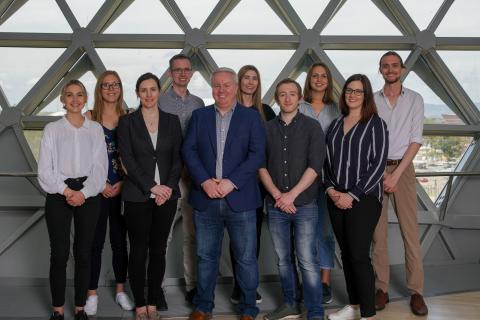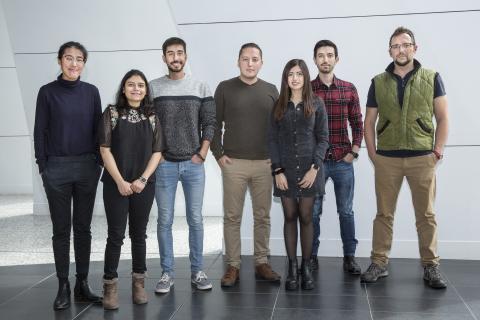The international research community is collaborating on a scale and at a speed never seen before to battle COVID-19 and EMBL Australia group leaders have answered the call to help.
This is how some of the group leaders in our Partner Laboratory Network are contributing to the global efforts to research, understand and conquer COVID-19:
PROF DAVID LYNN – BRACE TRIAL FOR PROTECTIVE VACCINE
EMBL Australia group leader Prof David Lynn is leading the South Australian arm of one of the largest vaccine trials underway against COVID-19.
The reach of the international BRACE trial, which tests whether the Bacillus Calmette-Guerin (BCG) vaccine can protect healthcare workers who contract COVID-19 from developing severe symptoms, was expanded last month after a $10 million grant from the Bill & Melinda Gates Foundation.
The trial – led by Professor Nigel Curtis at the Murdoch Children’s Research Institute – is aiming to recruit up to 10,000 healthcare workers across Australia, Spain and the Netherlands, with the assumption that healthcare workers are at greater risk of contracting the disease.

The trial builds on previous research that showed the BCG vaccine – originally developed for protection against tuberculosis – can provide some protection against respiratory viral infections and enhanced immunity to a virus with a structure of a similar type to that which causes COVID-19.
Prof Lynn, who is also a SAHMRI Group Leader and Flinders University Professor, said while there is evidence the vaccine can provide non-specific protection against respiratory infections, researchers don’t yet know whether it will provide any protection against COVID-19.
“It may well be that by the time we get an answer to that question, we have a specific vaccine against COVID-19 and that we don’t need BCG as an interim vaccine against COVID-19, even if we could see an effect,” Prof Lynn said.
“But if it’s clear that it works against this pandemic, then there is strong potential for this to be an interim measure in tackling future pandemics with newly emerging viruses.”
Prof Lynn said the implications of the study were far broader than just whether the vaccine provides a protective effect against COVID-19.
“And there are also significant implications for our understanding of how important BCG is from a global health perspective, unrelated to COVID-19,” he said.
“If we can demonstrate that it can provide non-specific protection against this, then it can be potentially be used in many other settings.”

In the multi-centre, randomised, controlled trial, half the participants will be given the BCG vaccine and compared with a control group to determine whether they are less likely to be infected with SARS-CoV-2 or whether BCG reduces their symptoms in the event of contracting the virus.
Over 12 months, participants will be observed to see whether those who received the BCG vaccine either have fewer cases of COVID-19 or reduced symptoms.
Prof Lynn has been studying the non-specific effects (effects on infections unrelated to the particular pathogen the vaccine is targeting) of vaccines like BCG in pre-clinical models for a number of years.
Prof Lynn and his colleagues have recently authored a viewpoint article in a prominent review journal, Nature Reviews Immunology, on the evidence behind the non-specific effects of vaccines, including the rationale for the BRACE trial.
Find more information about the BRACE Trial, including how to enrol, here.
PROF EDUARDO EYRAS – AI TOOL TO DETECT VIRAL CO-INFECTIONS
Professor Eduardo Eyras, along with his team and collaborators, has developed a tool to detect viral co-infections in COVID-19 patients to help develop informed strategies for antiviral treatment, vaccination and epidemiological control in the COVID-19 pandemic.
Various studies report that around 20 percent of SARS-CoV-2-positive individuals had a co-infection with other respiratory viruses and that these coinfections may increase the severity of the disease by altering disease progression and response to treatment.
Prof Eyras, who is based at the John Curtin School of Medical Research at ANU, said identifying those co-infections will be relevant for treatment and prognostic purposes, however, the current standard of viral detection is based on PCR assays directed to SARS-CoV-2 only, which will miss possible co-infecting viruses.
Prof Eyras said the new method, called PACIFIC, can identify SARS-CoV-2 and 361 other viruses at a sample concentration as low as 0.03%, with high specificity (low false-positive rate).
“With PACIFIC, we are trying to provide a fast and easy-to-use, end-to-end tool that will enable researchers to monitor viral infections and co-infections to help manage the global COVID-19 pandemic.”

The new computational tool, based on artificial intelligence for natural language processing, detects viral co-infections from COVID-19 patient samples analysed with high-throughput sequencing (HTS).
HTS enables the unbiased detection of RNA molecules present in a patient sample and can be performed on blood, sputum or any other patient sample.
Prof Eyras and his colleagues decided to develop a tool to identify SARS-CoV-2 and other potential viruses from the pool of HTS reads (i.e. the fragments of the RNAs measured from the sample).
To achieve this, the tool had to be able to identify the virus type from the RNA sequencing reads, and do this confidently enough for as many reads as possible.
“This is similar to language processing, where you recognise and classify texts, and organise them into organised groups,” Prof Eyras said.
“We trained this model with examples of sequences that come from multiple viruses and from humans, and the model learns to separate them.”
Read more about Prof Eduardo Eyras’ work here.
DR YANN GAMBIN – RESEARCHING ANIMAL MODELS AND HYPER-INFLAMMATION
Dr Yann Gambin – based at EMBL Australia’s node in Single Molecule Science at UNSW – and his team have been researching why Covid-19 affects minks, cats and tigers, but not other animals, and the molecular mechanism for hyper-inflammation.
The research will help inform new antiviral strategies and enable the development of more effective animal models for COVID-19.
The study also shows that one species of bat presents high similarities with humans and would have enabled the coronavirus to gain pathogenicity.
Read the full publication, ‘SARS-CoV-2 proteases cleave IRF3 and critical modulators of inflammatory pathways (NLRP12 and TAB1): implications for disease presentation across species and the search for reservoir hosts’, or more about Yann Gambin’s work here.
A/PROF VILLE-PETTERI MÄKINEN – PLATFORM FOR COLLECTING DATA & MATCHING SKILLS
Associate Professor Ville-Petteri Mäkinen, based at SAHMRI, is an Algorithm Team leader for the Australian Alliance for Artificial Intelligence in Healthcare (AAAiH), which is creating a national COVID-19 AI research platform to fast-track development of clinical AI and data analytic technologies by aggregating information about the different COVID-19 algorithms and data sets available and matching skilled researchers with COVID-19 projects.
Read more about Ville-Petteri Mäkinen’s work here.